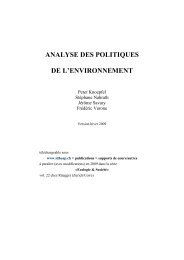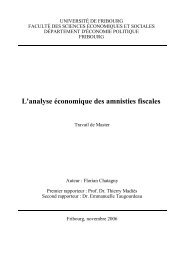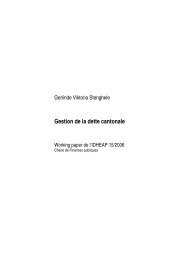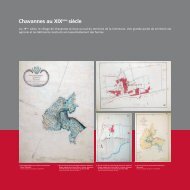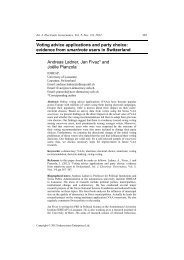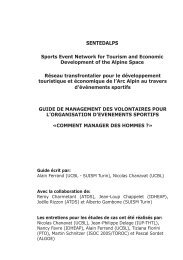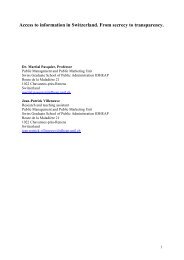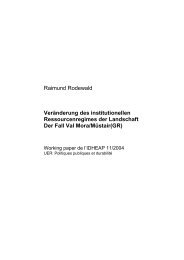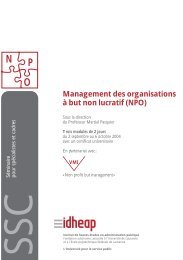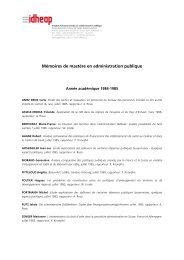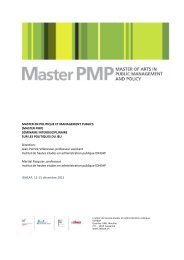Historical Analysis of Institutional Regimes in Switzerland ... - IDHEAP
Historical Analysis of Institutional Regimes in Switzerland ... - IDHEAP
Historical Analysis of Institutional Regimes in Switzerland ... - IDHEAP
Create successful ePaper yourself
Turn your PDF publications into a flip-book with our unique Google optimized e-Paper software.
24<br />
This last measure to be adopted as part <strong>of</strong> water policy also promotes the aims <strong>of</strong> nature<br />
conservation.<br />
As early as the com<strong>in</strong>g <strong>in</strong>to force <strong>of</strong> the Swiss Civil Code, restrictions were applied to the private<br />
ownership <strong>of</strong> water and these were <strong>in</strong>tensified <strong>in</strong> the course <strong>of</strong> time due to the urgency <strong>of</strong> public<br />
<strong>in</strong>terests <strong>in</strong> terms <strong>of</strong> water sources for use and water protection. This can be seen <strong>in</strong> almost all <strong>of</strong> the<br />
above-described changes to the constitution and legislation. The successive changes <strong>of</strong> the public<br />
policies - and hence the content <strong>of</strong> the ownership <strong>of</strong> water – can be <strong>in</strong>terpreted as reactions to the<br />
scarcity <strong>of</strong> “clean” (dr<strong>in</strong>k<strong>in</strong>g) water and later <strong>of</strong> water bodies as landscape elements and<br />
Lebensraum for animals and plants.<br />
c) Soil (Property Rights-driven Trajectory)<br />
The debate dur<strong>in</strong>g the first half <strong>of</strong> the last century centred on the basic pr<strong>in</strong>ciples <strong>of</strong> ownership <strong>of</strong> soil<br />
and its sale: the key issues here were ownership, transmission, expropriation, purchase, sale,<br />
mortgages, leas<strong>in</strong>g, usufruct. The political struggle surround<strong>in</strong>g the resource <strong>of</strong> soil was clearly a<br />
symbolical and economic one (private versus state ownership). Moreover, the regulation <strong>of</strong> the<br />
disposition and ownership <strong>of</strong> soil/land embodied a perennial theme throughout the last century.<br />
Hence, clear - formally absolute - property and use rights were def<strong>in</strong>ed as part <strong>of</strong> land reform (Land<br />
Reform <strong>of</strong> 1969).<br />
Restrictions <strong>in</strong> disposal and use rights were not imposed until a later stage by means <strong>of</strong> public<br />
policies: worthy <strong>of</strong> mention here are the Law on the Protection <strong>of</strong> Waters and regional development<br />
policy which was extremely <strong>in</strong>fluential as a result <strong>of</strong> its <strong>in</strong>troduction <strong>of</strong> construction and nonconstruction<br />
zones (Land Law Article 1969; AFU 1972, LAT 1979). Further <strong>in</strong>terventions <strong>in</strong> the<br />
ownership and disposal <strong>of</strong> land were imposed through the Federal Law on Environmental Protection,<br />
the Rothenturm Initiative and the Federal Law on Agriculture. While <strong>in</strong>itially the emphasis was on the<br />
quantitative protection <strong>of</strong> soil, subsequent public policies were ma<strong>in</strong>ly concerned with qualitative<br />
protection (Forest Law 1992: Biodiversity, Federal Law on the Reform <strong>of</strong> Agricultural Land 1994,<br />
Revised Law on Environmental Protection Act 1997, Direct Payments Decree 1998, Revised Law<br />
on Regional Development1999). The development trajectory can be described as property rights,<br />
whereby, from the 1970s on, the use and property rights were <strong>in</strong>creas<strong>in</strong>gly concretised through<br />
sectoral policies.<br />
d) Forest (Parallel Trajectory)<br />
With a few exceptions, the changes to the forest regime rights have been m<strong>in</strong>or. Ownership structure<br />
has rema<strong>in</strong>ed quite stable. The <strong>in</strong>troduction <strong>of</strong> the Swiss Civil Code <strong>in</strong> 1907 with the general<br />
def<strong>in</strong>ition <strong>of</strong> property and the public access right can be considered a major change. With the new<br />
Federal Law on Forests, the duty to manage forests has been slightly extended and now also applies<br />
to private forests (Leimbacher/Perler 2000: 228). Partition<strong>in</strong>g is still subject to authorisation but it is<br />
no longer an explicit objective <strong>of</strong> forest policy to reduce plott<strong>in</strong>g and change the ownership structure.<br />
At the end <strong>of</strong> 20 th century, protection was no longer exclusively quantitative <strong>in</strong> nature but also<br />
<strong>in</strong>cluded qualitative aspects. The new Federal Law on Forests stresses the qualitative protection <strong>of</strong><br />
forests: the purpose <strong>of</strong> this legislation is “to protect the forest as natural environment” (Article 1 al. b<br />
WaG). Up to 50% f<strong>in</strong>ancial support is provided for protective measures for the upkeep <strong>of</strong> forest<br />
reserves by the federal authorities (Article 38 al. 3 WaG). In Article 38 al. 2b WaG, f<strong>in</strong>ancial



